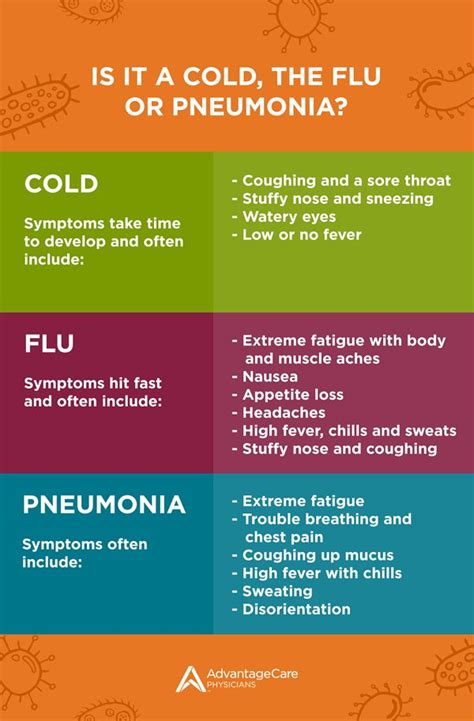When it comes to respiratory infections, two of the most common and potentially severe conditions are the flu (influenza) and pneumonia. While both can have significant impacts on a person’s health, they are distinct illnesses with different causes, symptoms, and treatments. Understanding the differences between the flu and pneumonia is crucial for seeking the appropriate medical care and preventing complications.
Causes and Risk Factors
The flu, or influenza, is a contagious respiratory illness caused by influenza viruses. It can spread through droplets made when people with the flu cough, sneeze, or talk, or by touching surfaces or objects that have the flu virus on them and then touching their mouth, nose, or eyes. The risk factors for getting the flu include being around others who are sick, not getting vaccinated, and having certain health conditions or a weakened immune system.
Pneumonia, on the other hand, is an infection that inflames the air sacs in one or both lungs. The air sacs may fill with fluid or pus (purulent material), causing cough with phlegm or pus, fever, chills, and difficulty breathing. Pneumonia can be caused by bacteria, viruses, or fungi. The risk factors for developing pneumonia include age (being very young or elderly), having a weakened immune system, and having certain health conditions such as heart disease, diabetes, or chronic lung disease.
Symptoms
While the flu and pneumonia share some symptoms, there are key differences. The flu typically comes on suddenly and can cause:
- High fever
- Chills
- Cough
- Sore throat
- Runny or stuffy nose
- Muscle or body aches
- Headaches
- Fatigue (tiredness)
- Diarrhea and vomiting (more common in children than adults)
Pneumonia often starts with symptoms similar to those of the flu but can progress to more severe symptoms such as:
- High fever, which may be intermittent
- Chills
- Cough, which may produce phlegm or pus
- Shortness of breath
- Chest pain that worsens with deep breathing or coughing
- Fatigue
- Loss of appetite
- Confusion, especially in older adults
Diagnosis and Treatment
Diagnosing the flu or pneumonia involves a combination of physical exams, medical history, and sometimes lab tests. For the flu, rapid influenza diagnostic tests (RIDTs) can provide results in about 15-30 minutes. However, these tests may not always detect the flu virus.
The diagnosis of pneumonia typically involves a physical exam, where the doctor will listen to your lungs with a stethoscope to check for abnormal sounds. Imaging tests like chest X-rays and sometimes computed tomography (CT) scans can help confirm the diagnosis. Blood tests and taking a sample of your mucus or phlegm may also be necessary to identify the cause of pneumonia.
Treatment for the flu usually focuses on relieving symptoms and includes rest, hydration, and over-the-counter medications to reduce fever and relieve body aches. In some cases, especially for those at high risk of complications, antiviral drugs like oseltamivir (Tamiflu) or zanamivir (Relenza) may be prescribed.
For pneumonia, treatment depends on the type and severity of the infection. Bacterial pneumonia is typically treated with antibiotics, while viral pneumonia may not require specific antiviral treatment but may involve medications to manage symptoms. Fungal pneumonia requires antifungal medications. In severe cases, hospitalization may be necessary to support breathing and recovery.
Prevention
Preventing the flu and pneumonia involves similar strategies. Annual flu vaccination is recommended for everyone 6 months of age and older, with a few exceptions. Vaccines are also available to prevent some types of pneumonia, such as the pneumococcal vaccine, which protects against infections caused by Streptococcus pneumoniae.
Practicing good hygiene, including frequent handwashing, covering your mouth and nose with a tissue when you cough or sneeze, and avoiding close contact with people who are sick, can help prevent the spread of both the flu and pneumonia.
Maintaining a healthy lifestyle by not smoking, getting enough rest, staying physically active, managing chronic conditions, and getting enough nutrients can also help keep your immune system strong, reducing your risk of developing severe infections.
Complications
Both the flu and pneumonia can lead to serious complications, especially in individuals with underlying health conditions or a weakened immune system. Complications of the flu include pneumonia, bronchitis, sinus and ear infections, and in severe cases, heart attacks, strokes, and organ failure.
Pneumonia complications can range from mild to life-threatening and include bacteremia (bacteria in the bloodstream), sepsis (a life-threatening response to infection), acute respiratory distress syndrome (ARDS), and lung abscess.
Conclusion
In conclusion, while both the flu and pneumonia are respiratory infections, they have distinct causes, symptoms, and treatments. Understanding these differences and taking proactive steps to prevent these illnesses, such as getting vaccinated and practicing good hygiene, can significantly reduce the risk of infection and potential complications. If symptoms persist or worsen, seeking medical attention promptly is crucial for proper diagnosis and treatment.
FAQ Section
How can I differentiate between the flu and pneumonia based on symptoms alone?
+Differentiating between the flu and pneumonia based solely on symptoms can be challenging because they share many similarities. However, pneumonia often presents with more severe symptoms such as high fever, chills, and cough that produces phlegm or pus. Additionally, shortness of breath and chest pain that worsens with deep breathing or coughing are more indicative of pneumonia. If you're unsure, it's always best to consult a healthcare professional for an accurate diagnosis.
<div class="faq-item">
<div class="faq-question">
<h3>Can pneumonia be prevented, and if so, how?</h3>
<span class="faq-toggle">+</span>
</div>
<div class="faq-answer">
<p,Yes, pneumonia can be prevented to some extent. Vaccinations against certain types of pneumonia, such as pneumococcal and influenza vaccines, are highly effective. Additionally, practicing good hygiene, such as frequent handwashing, avoiding close contact with people who are sick, not smoking, and maintaining a healthy lifestyle by getting enough rest, staying physically active, and managing chronic conditions, can all reduce the risk of developing pneumonia.</p>
</div>
</div>
<div class="faq-item">
<div class="faq-question">
<h3>What are the potential complications of untreated pneumonia?</h3>
<span class="faq-toggle">+</span>
</div>
<div class="faq-answer">
<p>Untreated pneumonia can lead to serious and potentially life-threatening complications. These include bacteremia (bacteria in the bloodstream), sepsis (a life-threatening response to infection), acute respiratory distress syndrome (ARDS), and lung abscess. In severe cases, pneumonia can lead to respiratory failure, requiring mechanical ventilation, and can affect other parts of the body, leading to organ failure. Prompt medical attention is crucial to prevent these complications.</p>
</div>
</div>
<div class="faq-item">
<div class="faq-question">
<h3>How long does it take to recover from pneumonia, and what is the recovery process like?</h3>
<span class="faq-toggle">+</span>
</div>
<div class="faq-answer">
<p>The recovery time from pneumonia can vary significantly depending on the severity of the infection, the patient's overall health, and the effectiveness of the treatment. Generally, with proper antibiotic treatment, symptoms of pneumonia can start to improve within 24 to 48 hours, but it may take several weeks for the infection to clear completely and for strength and energy to return. The recovery process involves completing the full course of antibiotics as prescribed, getting plenty of rest, staying hydrated, and following a healthy diet. In some cases, especially for those who have been hospitalized, follow-up care with a healthcare provider is necessary to monitor recovery and address any lingering concerns.</p>
</div>
</div>
<div class="faq-item">
<div class="faq-question">
<h3>Can the flu turn into pneumonia, and if so, how common is this complication?</h3>
<span class="faq-toggle">+</span>
</div>
<div class="faq-answer">
<p,Yes, the flu can increase the risk of developing pneumonia. This is because the flu virus can lead to complications like pneumonia, especially in vulnerable populations such as the elderly, young children, and people with certain chronic health conditions. According to the CDC, people with the flu are at an increased risk of developing pneumonia, which can be caused by either the flu virus itself or by a secondary bacterial infection. Monitoring symptoms closely and seeking medical attention if they worsen or if signs of pneumonia appear can help prevent serious complications.</p>
</div>
</div>
<div class="faq-item">
<div class="faq-question">
<h3>What role does vaccination play in preventing the flu and pneumonia?</h3>
<span class="faq-toggle">+</span>
</div>
<div class="faq-answer">
<p>Vaccination plays a critical role in preventing both the flu and pneumonia. The flu vaccine is designed to protect against the most common flu viruses for the upcoming season and is recommended annually for everyone 6 months of age and older. Pneumococcal vaccines, on the other hand, protect against infections caused by Streptococcus pneumoniae and are recommended for young children, adults 65 years and older, and certain adults 19 through 64 years old with certain chronic conditions or other factors that increase their risk for pneumococcal disease. Vaccines not only prevent the diseases themselves but also reduce the risk of complications and the spread of infection to others.</p>
</div>
</div>
</div>


